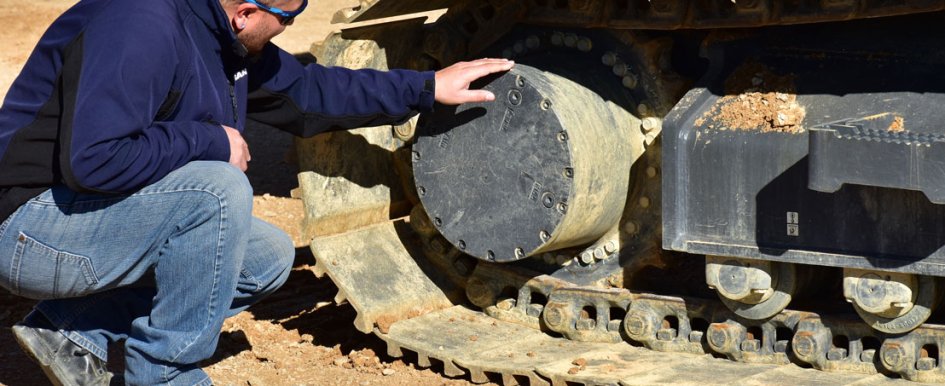
As the busy season approaches, it is important that you and your operators maintain a productive fleet of tracked heavy equipment, particularly crawler excavators, to ensure you stay on schedule. The most effective way to do this is by training your equipment operators on the proper operation and maintenance of the excavator undercarriage and its components as outlined in the manufacturer’s operation and maintenance manual. Reviewing the following undercarriage maintenance tips and operational best practices with your equipment operators may help you get better performance and life out of your crawler excavator’s steel track undercarriage.
Follow Basic Practices
The excavator’s undercarriage can represent a significant portion of your operating costs. It’s important to adhere to the manufacturer’s recommended operating procedures to minimize wear to the equipment. Some general operating tips you or your operators can follow to help minimize track and undercarriage wear include:
- Make wider turns—Sharp turns or pivoting the machine can lead to accelerated wear and increase the potential for detracking.
- Minimize time on slopes—Constant operation on a slope or hill in one direction can accelerate wear. However, many applications require slope or hillside work, so when moving the machine up or down a hill, make sure that the drive motor is in the correct position to reduce track wear. The drive motor should be facing the back of the machine for easy maneuverability up a slope or a hill.
- Avoid harsh environments—Rough asphalt or concrete and other abrasive materials can cause damage to tracks.
- Reduce unnecessary spinning—Train your operators to make wide, less-aggressive turns. Track spinning can lead to wear and decrease productivity.
Keep it Clean
Maintaining a clean undercarriage is critical to efficient operation. At the end of each day, excavator operators should clean out dirt and other debris that may lead to undercarriage buildup. If the undercarriage is not routinely cleaned, it will lead to premature wear on components. Debris can also add weight to the undercarriage, which reduces fuel economy.
Many excavator manufacturers offer undercarriages that are designed for easier track carriage cleanout, helping mud, dirt and debris fall to the ground, rather than become packed in the undercarriage. However, if there is an excess of dirt and debris, excavator operators can use shovels and pressure washers to clean out the undercarriage. Companies that specialize in mobile equipment cleaning can clear dirt and debris from not only your crawler excavator, but also all your tracked machines on a jobsite.
Complete a Full Inspection
Neglecting your excavator’s undercarriage can be costly. The best way to reduce unwarranted expenses is to complete a full undercarriage inspection for excessive or uneven wear, as well as look for damaged or missing components. The following jobsite mainstays should be inspected on a routine basis:
- Drive motor
- Drive sprockets
- Main idlers
- Rock guards
- Rollers
- Track bolts
- Track chains
- Track shoes
- Track tension
Check the tracks to see if any components look out of place. If so, this could indicate a loose track pad or a broken track pin. Rollers, idlers and drive motors and sprockets should be inspected for oil leakage. A failed seal could lead to major failure. Make repairs immediately, or contact your dealer’s service department for assistance.
Follow Proper Track Tension
An overlooked maintenance item on many tracked undercarriages is maintaining proper track tension. For instance, if steel tracks are too tight, they can quickly accelerate wear. If they are too loose, they could detrack and lead to unnecessary downtime. Generally, when operators are working in soft, muddy conditions, it is recommended to run the tracks slightly looser. In more abrasive conditions, tighter tracks are preferred. Always consult the manufacturer’s operation and maintenance manual for proper tension levels.
Use Rubber Tracks for Sensitive Surfaces
When working on soft ground conditions, it may be advantageous to use rubber tracks, which are available as an option on some smaller crawler excavators. The rubber tracks provide good flotation and have minimal ground disturbance on finished surfaces, such as concrete, grass and asphalt.
Partner with Your Dealership
Unplanned maintenance can result in a loss of production, higher costs for parts and increased service time, so work with equipment operators to create a planned maintenance schedule.
A schedule that is easy to follow helps control your cost of ownership by guarding against unexpected downtime that can often lead to costly repairs. You also may decide to develop a proactive, planned maintenance program with your dealership on a periodic basis. They have trained service technicians who can identify minor fixes before they become major repairs.
Plus, prearranged maintenance intervals make it possible to conveniently schedule machine service at a time and location that doesn’t disrupt your operators’ productivity. Some equipment dealers provide road-service technicians and truck drivers who travel to your jobsite to complete routine maintenance and diagnostics.
Your excavator undercarriage consists of many expensive components that need to be maintained by you or your operators on a consistent basis. If they adhere to proper operation and track maintenance, it can help extend the life of these components, keep your cost of ownership down and minimize machine downtime.
Where is My Operation & Maintenance Manual?
Your operation and maintenance manual is one of the best sources of information you have. You should have received one from your dealer when you purchased your machine. It can be big and bulky, and you may have filed it away in your office or in storage. Now is the time to get it out and review it with your operators. If you have lost your copy, contact your local dealer for a replacement. An electronic copy may be available, if you prefer that option.
